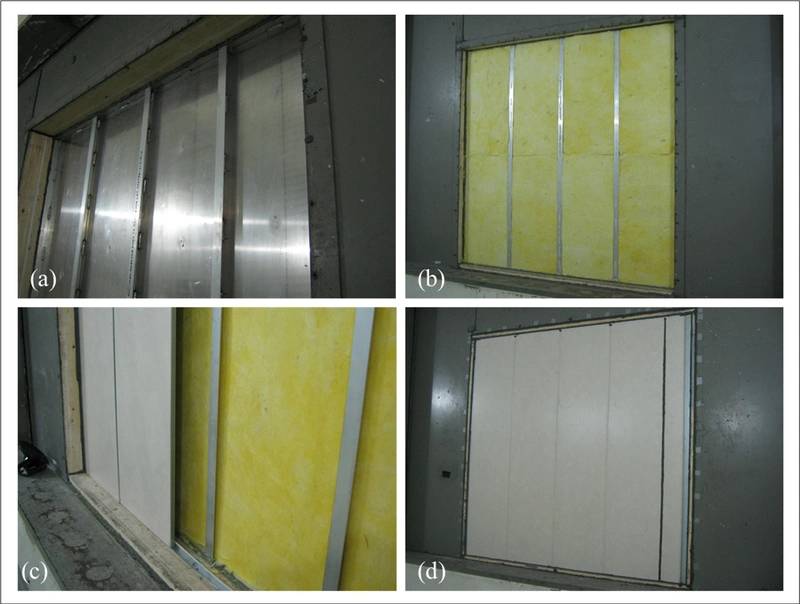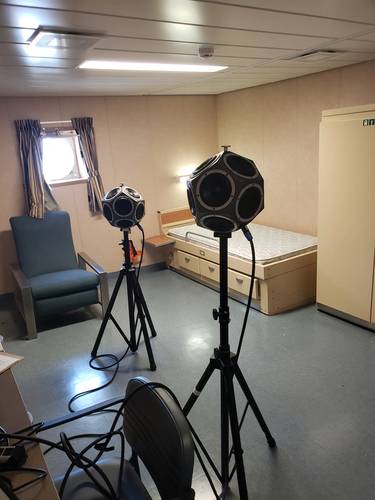ENGINEERING: Inter-Compartment Sound Transmission Regulations and Testing
Complying with International Maritime Organization Resolution MSC.337(91) Noise Level Code
One of the best things a marine operator can do for its crew or passengers is prioritize their comfort by reducing shipboard noise. Commercial and military marine vessels can be subject to very high noise levels produced by everything from onboard activities to aircraft. At worst, this noise can be hazardous—disruptively noisy environments can lead to discomfort, sleep-deprivation, and even hearing loss, which can in turn lead to lower job performance, safety risks, and diminished quality of life. Evidence shows that when noise levels are controlled, crews can be more productive and the potential for injury is reduced.
In response to the need for improved noise control measures, regulations around shipboard sound insulation and acoustical partition performance have become increasingly common. The International Maritime Organization (IMO) has adopted Resolution MSC.337(91) Code on Noise Levels Onboard Ships, which stresses that the sound transmission performance of partitions on certain vessels must meet specific requirements that allow for uninterrupted rest and recreation, regardless of noise in adjacent compartments. The purpose of the Code is to provide standards to prevent the occurrence of potentially hazardous noise levels on board ships and to provide standards for an acceptable environment for seafarers on passenger and cargo ships. The Code also includes requirements for measurements of noise levels and exposure.
While the IMO code is the primary regulation we have seen applied in the USA, many other regulatory bodies include a requirement for designed and tested partition performance including the American Bureau of Shipping (ABS), Lloyd’s Register, Det Norske Veritas (DNV) and others. The general trend in the more recent versions of these regulations is toward more common requirements for testing and verification of partition performance.
With the introduction of these stricter noise codes, the need for acoustic performance testing and enforcement is now greater than ever. Since IMO’s adoption of a noise code that includes partition sound reduction index (Rw) requirements, Noise Control Engineering (NCE) has been working with naval architects to ensure vessels meet R¬w criteria. We have also been conducting in-situ testing more frequently. In the process of assessing hundreds of partitions for multiple vessels we have learned some practical lessons. Results of this work were recently presented by NCE at the Institute of Noise Control Engineering’s NOISE-CON, North America’s largest noise control technical conference.
 Lab performance testing of typical marine partitions. Photo: Noise Control Engineering
Lab performance testing of typical marine partitions. Photo: Noise Control Engineering
Testing Methodology
The testing methodology involves the use of one or two omnidirectional sound sources operating in one of the rooms formed by the partition being evaluated. Sound levels are then measured at multiple locations in the source space, as well as on opposite side of the partition. The difference between the noise levels on either side of the partition are used to calculate a standard performance metric after accounting for the partition surface area, room size, and other acoustic effects. This testing is conducted in accordance with ISO standards referenced by the IMO code.
There are many details that have to be considered in order to accurately test partition performance. For example, testing dockside can involve high levels of background noise. When all HVAC, air, and ventilation equipment is secured and the vessel is empty during second shift, reduced noise levels are obtainable—but creating these testing conditions isn’t always practical. While the test standard does have some allowances for non-ideal background data, results must sometimes be presented with a caveat that assessing partition performance was limited by high background noise. Consequently, every effort should be made to reduce background noise during testing to obtain a clean data set.
In terms of design, installed partitions often do not perform as well as the manufacturer-published (lab-tested) Rw, due to many factors some of which are summarized here.
Partitions, Louvers and Door Jams
During a recent test, measurements were taken of sound passing through a partition dividing a crew lounge and a stateroom. According to the IMO code, partitions between these two types of spaces must achieve a rating of Rw 45. Tested in a lab, the double 1-inch joiner with a 2-inch air gap in between would provide a sufficient barrier. However, when installed on the vessel, this particular partition did not reach into the overhead structure; instead, it stopped at the drop ceiling and was flanked by noise traveling through the ceiling via the shared overhead space. Once the plane of the partition was extended upward through the overhead space with 2-inches of mineral wool, the partition met the requirements.
Ships are often required to have louvers in doors separating accommodation spaces for air circulation. When it comes to acoustics, this is effectively the same as having a large hole in the door, drastically reducing its ability to block sound. For some door designs, the louvre openings are offset from each other on either side of the door, allowing room for the inside to be lined with sound-absorbing insulation. This design can reduce the flanking path to the extent that the louver no longer significantly degrades the performance of the door.
Another typical flanking path for hallway-to-stateroom partitions is the door-jamb seal. When the seal is not large enough to fill the space between the door frame and the door, this can drastically reduce the partition’s performance. In a recent test of a large vessel, every partition with a door failed the Rw criteria because they had no door seals. After door seals were installed, the results were significantly improved. Some vessels include double seals which, when combined with a tortuous-path louvre, perform well.
Conclusion
Many partition details, such as flanking, challenge the effectiveness of sound insulation. Resolution MSC.337(91) Code on Noise Levels Onboard Ships is clear: Solutions must be designed that incorporate and remedy acoustical weak points such as those outlined in this article. Regardless of vessel type, careful partition design, installation, and testing will result in improved operations, regulatory compliance, and greater comfort for all aboard. Minimizing crewmember and passenger exposure to harmful or disruptive noise is crucial to protecting their health and happiness.
- Authors: Allan Beaudry and Jeffrey Hunt
The authors are engineers at Noise Control Engineering, LLC, an acoustical engineering-consulting firm, specializing in noise and vibration design, control, and measurement for the marine industry. [email protected]














